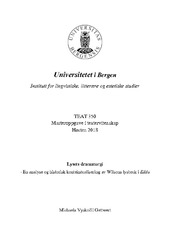Lysets dramaturgi - En analyse og historisk kontekstualisering av Wilsons lysbruk i Edda
Master thesis
Permanent lenke
https://hdl.handle.net/1956/19749Utgivelsesdato
2018Metadata
Vis full innførselSamlinger
- Master theses [274]
Sammendrag
In this thesis I inspect the role of theatre lighting from a theatre-historical and technological context using technic, aesthetic and semiotic perspectives in my analysis of Robert Wilsons Edda which premiered at Det Norske Teatret in Oslo, March 2017. With this in mind I wish to answer the question: In what way does Robert Wilson use lighting as a dramaturgical tool? I inspect the answer to this question in three parts: 1. through a short review of the development of lighting technology throughout history from renaissance to today, 2. through a definition chapter of modern lighting technology, terminology and characteristics and 3. the analysis of Edda. Through the review of the development of lighting technology I specifically touch on the subjects of the lighting of the baroque stage and the late 1800s, early 1900s theories of the swiss stage designer Adolphe Appia which Wilson seems to draw inspiration from. Thereafter, I define the diverse lighting instruments which are generally used in modern theatre. Subsequently I also touch a little bit on the specific lighting instruments that Wilson uses in Edda in order to thereafter be able to analyze the technologic and aesthetic parts of the performance thoroughly. Therefrom I continue my thesis to a semiotic analysis inspired by the lighting designer Yaron Abulafia in which he lays down “six grounds of representation.” These grounds of representation work as keys towards a conceptual discussion of specific light-images. Abulafia discusses the grounds of narrative, character, theme or (dramatic) action, atmosphere or emotion, sensation of light itself and open meaning. In conclusion of the thesis I discuss Wilsons lighting dramaturgy in historical and light technological perspectives, explicitly summarizing the baroque stage and Appia´s theories which are examined in the third chapter.
